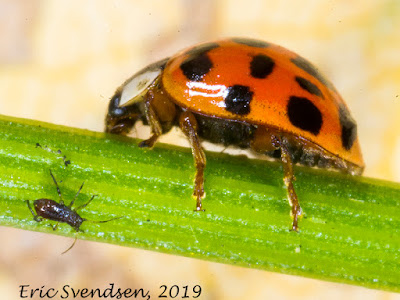How to get rid of a wasp's nest.
 |
| The yellow jacket wasp. |
If I have learned anything about wasps during my time on Mother Earth, it is that wasp nests only get bigger over time. It is better to deal with them now rather than later. It is one of those problems you simply cannot ignore and hope it goes away.
If you have ever played one of those computer games where you obtain resources and build an empire, the development of a wasp nest is something like that. A single wasp, a queen, slowly constructs a tiny enclave in some hopefully safe spot. Foraging for food, she builds a nest, lays her eggs, and tends the young until they mature. These underlings then go on to forage, build, and tend in a slowly exponential manner. Soon, small becomes big, then big becomes huge.
I was at the point in the "game" where there were about a dozen workers or so. The nest had become sizeable with 50 or 60 cells. Apparently, they had been busy. I could only imagine what it would look like in another month. It had to be dealt with soon. That brings me to this morning.
Thankfully there is a truth about wasps which can be exploited, one which I have utilized regularly. They remain motionless during cool mornings and cannot yet fly. Most insects need a minimum internal body temperature before the enzymes which facilitate muscle movement can be used effectively. If the temperature is low, their only choice is to employ a form of shivering to generate heat. All those hairs you see on the above photo help insulate them. However, it takes a minute or so before they can achieve flight. That is all the time I need.
Equipped with a shop vac and hose, I approached the enemy. After placing my instrument of death in a convenient spot, I turned it on. My "wand" was a vacuum accessory with a narrow end, and I carefully positioned it. Timing was everything. My first thrust went straight to the heart; Wasps gather together to keep warm, and they were in a tight little ball. My first strike was on the mark and the bulk of the group disappeared into the void. A few fell, and my feet became the tools of doom (shoes essential). In thirty seconds the nest was no more.
There is another fact about wasps which is important to know. They are quite tough. Even though they traveled through a giant wind tunnel at 200 km/hr and ended their journey by smashing into a hard plastic plate, they were only stunned. Taking off the vacuum lid, I then proceeded with the next phase of the operation. My weapon; a stick. As I parried and thrust it about in lightning speed, the wobbling creatures met their demise one at a time. Instead of shooting fish in a barrel, I was squishing wasps in a vacuum. Cruel, but efficient. Another minute of such swordplay and I was done.
Packing up my tools of destruction, I had won the game. Attacking without mercy at their weakest moment, demise was imminent. My kingdom was safe again. At least until the next incursion.
Thanks for reading. www.ericspix.com



Comments
Post a Comment